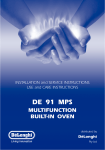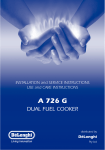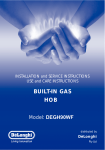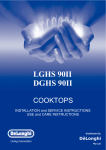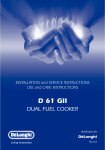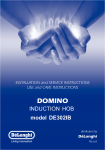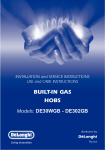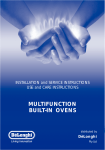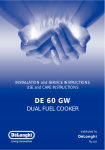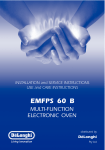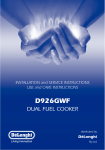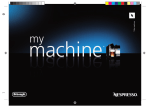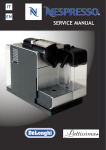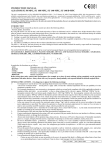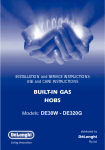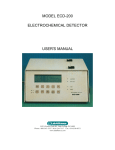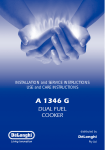Download De'Longhi Range DEGH70BG User's Manual
Transcript
IN STALLATI ON a n d S E RV I C E INST RUCT IONS US E a n d C A R E I N S T R UCT IONS BUILT-IN GAS ON GLASS HOBS Models: DEGH60BG - DEGH70BG - DEGH90BG distributed by DèLonghi Pty Ltd 2 Dear Customer, Thank you for having purchased and given your preference to our product. The safety precautions and recommendations reported below are for your own safety and that of others. They will also provide a means by which to make full use of the features offered by your appliance. Please keep this booklet in a safe place. It may be useful in future, either to yourself or to others in the event that doubts should arise relating to its operation. This appliance must be used only for the task it has explicitly been designed for, that is for cooking foodstuffs. Any other form of usage is to be considered as inappropriate and therefore dangerous. The manufacturer declines all responsibility in the event of damage caused by improper, incorrect or illogical use of the appliance or be faulty installation. PRODUCT LABEL This cooktop has been designed and constructed in accordance with the following codes and specifications: AGA101 (AS 4551) Approval Requirements for Domestic Gas cooking appliances AS/NZS 60335.1 General Requirements for Domestic electrical appliances AS/NSZ 60335.2.6 Particular Requirements for Domestic electrical cooking appliances AS/NZS CISPR 14.1 Electromagnetic Compatibility Requirements 3 IMPORTANT PRECAUTIONS AND RECOMMENDATIONS FOR USE OF ELECTRICAL APPLIANCES Use of any electrical appliance implies the necessity to follow a series of fundamental rules. In particular: ■■ Never touch the appliance with wet hands or feet. ■■ Do not operate the appliance barefooted. ■■ The appliance is not intended for use by young children or infirm persons without supervision. ■■ Young children should be supervised to ensure they do not play with the appliance. The manufacturer cannot be held responsible for any damages caused by improper, incorrect or illogical use of the appliance. IMPORTANT PRECAUTIONS AND RECOMMENDATIONS After having unpacked the appliance, check to ensure that it is not damaged. In case of doubt, do not use it and consult your supplier or a professionally qualified technician. Packing elements (i.e. plastic bags, polystyrene foam, nails, packing straps, etc.) should not be left around within easy reach of children, as these may cause serious injuries. ■■ ■■ ■■ ■■ ■■ ■■ ■■ ■■ ■■ ■■ ■■ ■■ ■■ ■■ 4 Do not attempt to modify the technical characteristics of the appliance as this may become dangerous to use. Do not carry out cleaning or maintenance operations on the appliance without having previously disconnected it from the electric power supply. After use, ensure that the knobs are in the off position. During and after use of the appliance, certain parts will become very hot. Do not touch hot parts. Household appliances are not intended to be played with by children. Keep children away from the appliance when it is in use. Children, or persons with a disability which limits their ability to use the appliance, should have a responsible person to instruct them in its use. The instructor should be satisfied that they can use the appliance without danger to themselves or their surroundings. Some appliances are supplied with a protective film on steel and aluminium parts. This film must be removed before using the appliance. WARNING: When correctly installed, your product meets all safety requirements laid down for this type of product category. However special care should be taken around the rear or the underneath of the appliance as these areas are not designed or intended to be touched and may contain sharp or rough edges, that may cause injury. This appliance is for domestic use only. Do not use the hob if the glass surface is broken or cracked in any way. Please disconnect the hob from the mains and contact the After-Sales Service. Do not scratch the hob with sharp objects. Don’t use the hob as a work surface. The manufacturer declines all liability for injury to persons or damage to property caused by incorrect or improper use of the appliance. IMPORTANT NOTE: This appliance shall not be used as a space heater, especially if installed in marine craft or caravans. INSTALLATION CAUTION: ■■ ■■ ■■ ■■ ■■ ■■ This appliance must be installed in accordance with these installation instructions, local gas fitting regulations, municipal building codes, water supply regulations, electrical wiring regulations, - Gas Installations and ony other relevant statutory regulations. This appliance shall be only be serviced by authorized personnel. This appliance is to be installed only by an authorised person. Incorrect installation, for which the manufacturer accepts no responsibility, may cause personal injury of damage. Always disconnect the appliance from mains power supply before carrying out any maintenance operations or repairs. In the room where the appliance is installed, there must be enough air to allow the gas to burn correctly, according to the current local regulations. ELECTRICAL REQUIREMENTS ■■ The appliance must be connected to the mains checking that the voltage corresponds to the value given in the rating plate and that the electrical cable sections can withstand the load specified on the plate. ■■ The plug must be connected to an earthed socket in compliance with safety standards. ■■ If the appliance is supplied without plug, fit a standard plug which is suitable for the power consumed by the appliance. ■■ The wires in the power cable are coloured in accordance with the following code: Green/Yellow = Earth, Blue = Neutral, Brown = Active. If the colours of the wires in the power cable to the appliance do not correspond with the coloured markings identifying the terminals in the junction terminal, proceed as follows: 1. The wire which is coloured green and yellow must be connected to the terminal marked E (Earth) or coloured Green. 2. The wire which is coloured blue must be connected to the terminal marked N (Neutral) or coloured Black. 3. The wire which is coloured brown must be connected to the terminal marked L (Live) or A (Active) or coloured Red. ■■ A suitable isolating switch providing full disconnection from the mains power supply (under overvoltage category III conditions) shall be incorporated in the permanent wiring, mounted and positioned to comply with the local wiring rules and regulations. The isolating switch must be of an approved type and provide a 3 mm air gap contact separation in all poles (or in all active [phase] conductors if the local wiring rules allow for this variation of the requirements). ■■ The power supply cable must not touch the hot parts and must be positioned so that it does not exceed 50°C above ambient. ■■ Once the appliance has been installed, the switch or socket must always be accessible. ■■ If the supply cord is damaged it must be replaced by the manufacturer or it’s Service Agent or a similarly qualified person in order to avoid a hazard. 5 N.B. The connection of the appliance to earth is mandatory. If the installation requires alterations to the domestic electrical system call a qualified electrician. He should also check that the socket cable section is suitable for the power drawn by the appliance. Replacing the power cord must be done by a qualified electrician in accordance with the instructions supplied by the manufacturer and in compliance with established electrical regulations. Figure 1 Figure 2 Mode l s: DE G H60B G, DE G H90B G Mo d e l: D E GH 70B G E L EC TR IC D IA GR A M K E Y EL EC T RI C DI A G RA M KE Y A PA CA M Ignit ion c oil I gnit ion s wit c h e s g ro u p S par k elec t r od e s Ter m inal bloc k Only for the model M N A PA CA M Igni ti on coi l Igni ti on sw i tches group S p ark el ectrodes Te rmi nal bl ock M L DE G H90 B G A A CA CA PA Only for the model D E G H 9 0 BG 6 PA L N CLEARANCES Installation clearances and protection of combustible surfaces shall comply with the current local regulations e.g. AS/NZS5601 - Gas Installations code. M o d el : DE G H 6 0 B G Model: D E GH 70B G 585 715 10 5 (2 60 54 (1) 48 0 48 0 54 (1) 60 (2 )( )( 3) 5 3) 10 560 560 Figure 3b Figure 3a Mo d e l: D EGH 9 0 B G 869 0 48 0 60 (2 54 (1) )( 3) 51 840 Figure 3c (1) 54 mm from top of countertop. (2) At least 60 mm between the back side of the cut-out and the back of the countertop. (3) At least 200 mm from the periphery of the nearest burner to any vertical combustible surface. If the distance from the periphery of the nearest burner to any vertical combustible surface, or vertical combustible surface with toughened glass or sheet metal, is less than 200 mm, the surface shall be protected (in accordance with AS/NZS5601) to a height of not less than 150 mm above the hob for the full dimension (width or depth) of the cooking surface area. Important note: This appliance shall not be used as a space heater, especially if installed in marine craft or caravans. 7 650 mm 450 mm M o d el : DE GH 6 0 B G 500 m m 212,5 mm minimum between the side of the cut-out and the side wall A M odel: D E GH 70B G 650 mm 450 mm Figure 4a 500 m m 260 mm minimum between the side of the cut-out and the side wall B Figure 4b 650 mm 450 mm M o d el : DE G H 9 0 B G A. 212.5 mm minimum between the side of 500 m m the cut-out and the side wall. B. 260 mm minimum between the side of the cut-out and the side wall. C. 214.5 mm minimum between the side of 214,5 mm minimum between the side of the cut-out and the side wall C 8 the cut-out and the side wall. Figure 4c IMPORTANT: see also item (3) at page no.7. The installation shall comply with the dimensions in Figures 3a, 3b or 3c and 4a, 4b or 4c, bearing in mind that: ■■ A partition between the base of the hob and the cupboard below should be fitted 30 mm below the workbench surface if the cupboard is to be used for storage. ■■ If the hob is installed over a built-in oven, the oven shall be provided with cooling fan motor. The two appliances shall be connected to the gas/electrical supply with independent connections. ■■ Overhead clearances - In no case shall the clearance between the highest part of the hob and a range hood be less than 600 mm, or for an overhead exhaust fan 800 mm. Any other downward facing combustible surface less than 600 mm above the highest part of the hob shall be protected for the full width and depth of the cooking surface area in accordance with local regulations inforce. However, in no case shall this clearance to any surface be less than 450 mm. Standards requirement Temperature of nearby surfaces. Australian and New Zealand Gas Installation Standards (AS/NZS5601) require a cooktop to be installed so that the surface temperature of any nearby combustible surface will not exceed 65°C above ambient. This is typically achieved by: ■■ having the cooktop spaced away from the wall (see figures 3a, 3b or 3c and 4a, 4b or 4c); AND ■■ protecting the wall to a height of at least 150 mm along its length (minimum height of non-combustible material when used on adjacent walls) with non-combustible surface materials such as: –– 5 mm-thick ceramic tiles (these alone are adequate); –– tempered glass or sheetmetal, minimum thickness 0.4 mm (acceptable when used in front of a fire resistant material). INSTALLING THE SEPARATOR BELOW THE BASE OF THE COOKTOP Clearance Separator 30 mm It is recommended that a 30 mm clearance be left between to base of the cooktop and the separator. The separator shall be heat resistant, made of low thermal conductivity material and shall be removable with the use of a tool for installation and service. Figure 5 Space for connections 9 FASTENING THE COOKTOP Each cooktop is provided with an installation kit including brackets and screws for fastening the cooktop to benches from 30 to 40mm thick. The kit includes two “F” type brackets (for the front of the cooktop), two “R” type brackets (for the rear of the cooktop) and four self-threading screws “S” (figs. 7a and 7b). –– Cut the unit according to the dimensions in fig. 3a or 3b. –– Turn the hob upside down and rest the glass side on a soft surface. –– Spread the seal “G” around the edge of the hob (fig. 6). –– Fasten the brackets “F” and “R” to the appropriate socket holes, without tightening the screws “S” for the moment. Make sure that the tabs are mounted correctly, as shown. Rotate the tabs so that the cooktop can be put into the cutout. –– Put the cooktop into the cutout and position it correctly. –– Put the brackets “F” and “R” into place; tooth “A” of the brackets should go into the hole (Figs. 7a and 7b). –– Tighten screws “S” until the cooktop is completely secured to the bench. –– Using a sharp cutter or trimmer knife, trim the excess sealing material around the edge of the cooktop. Take care not to damage the workbench. G G Front Fixing Brackets A Figure 7a 10 3 cm min S 3 cm min A R 3 cm 3 cm 4 cm Rear Fixing Brackets Adhesive side S 4 cm Figure 6 F Figure 7b GAS SUPPLY ■■ This appliance is suitable for use with Natural Gas or ULPG (Check the “gas type” sticker attached to the appliance). ■■ For Natural Gas the gas supply must be regulated to obtain a pressure of 1 kPa with the two semi-rapid (SR) burners operating at the maximum. ■■ For ULPG models connect the gas supply directly to the appliance test point adaptor (supplied with the conversion kit) and ensure that the supply pressure is regulated to 2.75 kPa. ■■ Do NOT force the ”elbow“ rotation prior to loosening nut. ■■ Do NOT over tighten the nut at the ”elbow“. 1. After connecting the gas supply, check the piping and connections for leaks using a soap and water solution. The presence of bubbles indicates a leak, tighten or replace connections as appropriate. Warning: Do not use any naked flame to check for leaks. 2. The operation of the appliance MUST be tested before leaving. 3. Adjust the test point pressure or supply pressure to the value which is appropriate for the gas type. 4. Turn on the appliance gas controls and light each burner. Check for a well defined blue flame without any yellow tipping. If any abnormality is evident then check that the burner cap is located properly and the injector nipple is aligned correctly. Gas connection for NATURAL GAS Test point Gas connection for ULPG Gas inlet pipe Gas inlet pipe Gasket Gasket Brass conical adaptor (Thread tight: use suitable seal) Test point adaptor Gas regulator Figure 8a Test point Figure 8b 11 5. Check the minimum burner setting by quickly rotating the gas control knob from the maximum to the minimum position, the flame must not go out. If adjustment is required carry out the “minimum burner setting adjustment” procedure described below. 6. If satisfactory performance cannot be obtained, the installer shall check the installation and notify the local gas supply authority for a gas supply problem, or if it is an appliance problem, our Customer Service Centre should be called to obtain the nearest authorized Delonghi Service Agent. 7. Where the appliance data plate cannot be easily read with the appliance in the installed position the duplicate data plate must be attached to adjacent surface and the duplicate Natural gas / ULPG conversion label should also be included where a Natural gas / ULPG conversion has been completed. INSTALLATION WITH A FLEXIBLE HOSE ASSEMBLY ■■ If this appliance has to be installed with a hose assembly, the installer shall refer to the network operator or gas supplier for confirmation of the gas type, if in doubt. ■■ When used with a flexible hose, the connector on the wall should be between 800 mm to 850 mm above the floor and in the region outside the width of the appliance to a distance of 250 mm. The supply connection point shall be accessible with the appliance installed. ■■ Flexible hose assemblies should be AS/NZS 1869 Class B or Class D certified. The thread connection shall be Rp 1/2” (ISO 7-1) male. ■■ IMPORTANT WARNING: After connection the installer must check that the hose is not kinked, subjected to abrasion or permanently deformed. The installer must check also that the hose is not near (or in contact) with any hot surfaces e.g. base of metal hotplate, underbench oven etc. ■■ The hose assembly shall be as short as practicable and comply with relevant AS/NZS5601 requirements. ■■ IMPORTANT WARNING: The installer shall ensure the hose assembly is restrained from accidental contact with the flue outlet of an underbench oven. Figure 9 12 TABLE FOR THE CHOICE OF THE INJECTORS Natural Gas ULPG 1.0 2.75 Test Point Pressure [kPa] Injector Orifice Dia. [mm] Gas Consumption [MJ/h] Injector Orifice Dia. [mm] Gas Consumption [MJ/h] Auxiliary (AUX) 0.85 3.60 0.53 3.60 Semi-rapid (SR) 1.12 6.30 0.70 6.30 Rapid (R) 1.45 10.40 0.91 10.80 Triple-ring (TR) (*) 1.60 12.70 0.95 11.90 BURNER (*) Only for the models DEGH70BG, DEGH90BG (Note: Gas type sticker and data plate are attached to the underside of the base of the appliance.) 13 CONVERSION PROCEDURE (to convert to Natural gas or to ULPG) REPLACING THE INJECTORS The conversion procedure must be carried out only by an authorised person. This appliance is suitable for use with Natural gas or Universal LPG (check the “gas type” sticker attached to the appliance). The nominal gas consumption and injector size details are provided in table at page 13. To replace the injectors proceed as follows: ■■ Remove pan supports and burners from the cooktop. ■■ Using a spanner, remove the injector “J” (figs. 10a, 10b) and replace it with one according to the gas type (see table - page 13). ■■ Affix to the appliance the warning label stating that the cooktop has been converted for use with Natural gas/ULPG (supplied with the Natural gas/ULPG conversion kit). A second Natural gas/ULPG conversion label should also be affixed to an adjacent surface along with the duplicate data plate. IMPORTANT ■■ If the cooktop is suitable for use with Natural gas and must be converted for use with Universal LPG, before connecting to gas main remove the appliance gas regulator and replace with test point adaptor (see figs. 8a, 8b). ■■ If the cooktop is suitable for use with Universal LPG and must be converted for use with Natural gas, before connecting to the gas main remove the appliance test point adaptor and replace with gas regulator (see figs. 8a, 8b). NOTE: Gas regulator and test point adaptor are supplied with the appliance (packed with conversion kit). The burners are designed so that regulation of primary air is not required. Only for the models with triple-ring burner (DEGH70BG, DEGH90BG) J Figure 10a 14 J Figure 10b MINIMUM BURNER SETTING ADJUSTMENT Check whether the flame spreads to all burner ports when the burner is lit with the gas tap set to the minimum position. If some ports do not light, increase the minimum gas rate setting. Check whether the burner remains lit even when the gas tap is turned quickly from the maximum to the minimum position. If the burner does not remain lit, increase the minimum gas rate setting. The procedure for adjusting the minimum gas rate setting is described below. • using a screwdriver turn screw “A” until the flame setting is correct (fig. 11). Auxiliary, Semi-rapid and Rapid burner Normally for ULPG fully tighten the adjustment screw. Triple-ring burner (only for the models DEGH70BG, DEGH90BG) Normally for ULPG fully tighten the adjustment screw, then turn the screw 3/8 anticlockwise. LUBRICATING THE GAS TAP If a gas tap is difficult to turn, disassemble it, clean it carefully with petrol and spread a little high-temperature-resistant grease on it. These operations must be performed by an Authorized person/Service agent. Note: Servicing of this appliance is only to be carried out by Authorised Person. Figure 11 A 15 USE and CARE CAUTION: ■■ This appliance must be used only for the task it has explicitly been designed for, that is for domestic cooking of foodstuffs. Any other form of usage is to be considered as inappropriate and therefore dangerous. Do not use this appliance as a space heater. ■■ Do NOT place combustible materials or products on this appliance at any time. Do NOT use or store flammable materials near this appliance. ■■ Do NOT spray aerosols in the vicinity of this appliance while it is in use. ■■ Before using for the first time, clean the cooktop with warm soapy water. ■■ Do NOT modify this appliance. ■■ IMPORTANT NOTE: This appliance shall not be used as a space heater, especially if installed in marine craft or caravans. Mo d e l: D EGH 6 0 B G 3 2 1 2 3 2 Figure 12a 5 16 9 10 11 9 Mo d e l: D EGH 7 0 B G 2 2 3 2 1 4 3 Figure 12b 9 8 7 6 5 Mo d e l: D EGH 9 0 B G 2 2 2 4 1 3 1 Figure 12c 5 9 8 6 7 GAS BURNERS CONTROL KNOBS 1. Auxiliary (AUX) 3.60 MJ/h 5. Burner 1 (Auxiliary) 2. Semi-rapid (SR) 6.30 MJ/h 6. Burner 2 (right Semi-rapid) 3. Rapid (R) 7. Burner 4 (Triple-ring) 10.40 MJ/h (NG) 10.80 MJ/h (ULPG) 4. Triple ring (TR) 12.70 MJ/h (NG) 11.90 MJ/h (ULPG) 8. Burner 2 (left Semi-rapid) 9. Burner 3 (Rapid) 10. Burner 2 (rear right Semi-rapid) 11. Burner 2 (front right Semi-rapid) NOTE: The models have a safety valve system fitted, (probe “T” close to the burner - see figures 18 and 21) the flow of gas will be stopped if and when the flame should accidentally go out. The appliances are fitted with a gas-lighter incorporated into the knobs. 17 USING GAS BURNERS ■■ Check that the electricity is switched on to allow spark ignition. ■■ Make sure that all controls are turned to zero. ■■ The gas flow to the burner is controlled by a tap incorporating a safety cut-off valve. If the burner flame should go out for some reason, the safety valve will automatically stop the gas flow. The switch of the electric ignition is incorporated in the knobs. ■■ You control the flow by turning the knob indicator to line up with the following symbols: –– Symbol –– Symbol –– Symbol 0 : tap closed (burner off) : High (maximum) : Low (minimum) ■■ You can control the temperature by the knob to “High” (maximum) from “Low” “Minimum”. ■■ To switch off, turn the knob clockwise until you hear the safety click. ■■ Note that, if you are using a burner at the minimum setting, you turn the knob clockwise past the maximum setting before reaching the off position. ■■ Whenever lighting any of the burners produces an abnormal flame, switch that burner off and relight using the minimum setting. ■■ If after relighting the burner, the flame is still abnormal, turn the burner off and contact our Customer Service Centre to obtain the nearest authorized Delonghi Service Agent. ■■ In the case of a mains failure light the burner with a match or lighted taper. ■■ Note: When the cooker top is not being used, set the gas knobs to their closed positions and also close the cock valve on the gas bottle or the main gas supply line. Figure 13a 18 Figure 13b LIGHTING GAS BURNERS FITTED WITH FLAME FAILURE SAFETY DEVICE In order to light the burner, you must: 1. Turn the knob (figs. 13a - 13b) in anti-clockwise direction up to the maximum aperture (symbol ), push in and hold the knob; this will light the gas. If there is no mains electrical supply, bring a lighted match close to the burner. 2. Wait for about ten seconds after the gas burner has been lit before letting go of the knob (valve activation delay). 3. Adjust the gas valve to the desired position. Important ■■ If the burner flame should go out, the safety valve will automatically stop the gas flow ■■ To re-light the burner, return the knob to closed “0” position (burner off), wait for at least 1 minute and then repeat the lighting procedure. ■■ N.B. If your local gas supply makes it difficult to light the burner with the knob set to maximum, set the knob to minimum and repeat the operation. COOKING HINTS FOR GAS HOBS ■■ ■■ ■■ ■■ ■■ ■■ ■■ ■■ ■■ ■■ ■■ ■■ ■■ ■■ Burners Pan Diameter Auxiliary (AUX) 6 to 14 cm The burner must be chosen according to the diaSemi-rapid (SR) 16 to 24 cm meter of the pans and energy required. Rapid (R) 24 to 26 cm The largest can be used for boiling, to seal meat or foods that are cooked quickly, and the smallest Triple-ring (TR) (*) 26 to 28 cm for stews and sauces. Wok pans max 36 cm Always ensure that you use the correct size of (*) Only for the models DEGH70BG, saucepan. DEGH90BG For fast boiling, make sure the flame just reaches Figure 14 the edge of the pan. Flames going up the side of the pan means wasted heat and the contents of the pan will take longer to boil. For optimum efficiency use a wok or pan no smaller than 230mm diameter. do not use pans with Saucepans with handles which are excessively concave or convex bases heavy, in relationship to the weight of the pan, are safer as they are less likely to tip. Pans which are positioned centrally on burners are more stable than those which are offset. It is far safer to position the pan handles in such a way that they cannot be accidentally knocked. When deep fat frying fill the pan only one third full of oil. DO NOT cover the pan with a lid and DO NOT leave the pan unattended. In the unfortunate event of a fire, leave the pan where it is and turn off all controls. Place a damp cloth or correct fitting lid over the pan to smother the flames. DO NOT use water on the fire. Leave the pan to cool for at least 30 minutes. WARNING - VERY IMPORTANT NOTICE During use cooking vessels become hot. Pay special attention not to touch the hot vessels positioned on the cooking hob especially when operating the control knobs. 19 CORRECT USE OF TRIPLE-RING BURNER (ONLY FOR THE MODELS DEGH70BG, DEGH90BG) ■■ The flat-bottomed pans are to be placed directly onto the pan-support. ■■ To use the WOK, you must place the wok stand in the CORRECT position as shown in fig. 15b. IMPORTANT: The special grille for wok pans (fig. 15b) MUST BE PLACED ONLY over the pan-rest for the triple-ring burner. Figure 15a Figure 15b WRONG 20 CORRECT Do not place anything, e.g. flame tamer, asbestos mat, between pan and pan support as serious damage to the appliance may result. Do not remove the pan support and enclose the burner with a wok stand as this will concentrate and deflect heat onto the hotplate. Do not use large pots or heavy weights which can bend the pan support or deflect flame onto the hotplate. Locate pan centrally over the burner so that it is stable and does not overhang the appliance. Use only a wok support supplied or recommended by the manufacturer of the appliance. Figure 16 21 CLEANING and MAINTENANCE GENERAL ADVICE ■■ ■■ ■■ ■■ ■■ ■■ Before you begin cleaning you must ensure that the hob is switched off. It is advisable to clean when the appliance is cold and especially when cleaning the enamelled parts. All enamelled surfaces have to be washed with soapy water or some other non-abrasive product with a sponge and are to be dried preferably with a soft cloth. Avoid leaving alkaline or acid substances (lemon juice, vinegar etc.) on the surfaces. Do not use cleaning products with a chlorine or acidic base. Do not use harsh abrasive cleaners or sharp metal scrapers to clean the glass since they can scratch the surface, which may result in shattering of the glass. WARNING: When correctly installed, your product meets all safety requirements laid down for this type of product category. However special care should be taken around the underneath of the appliance as this area is not designed or intended to be touched and may contain sharp or rough edges, that may cause injury. GLASS SURFACE ■■ ■■ ■■ ■■ ■■ ■■ ■■ ■■ ■■ Remove spillages and other types of incrustations by using only specific products which do not contain abrasives or chlorine-based acids. If you use a detergent, please make sure that it is not abrasive or scouring. Abrasive or scouring powders can damage the glass surface of the hob. All traces of the cleaner must be removed with a damp cloth. Dust or food particles can be removed with a damp cloth. Dust, fat and liquids from food that has boiled over must be removed as soon as possible. If they are allowed to harden they become increasingly difficult to remove. This is especially true in the case of sugar/syrup mixtures which could permanently damage the surface of the hob if left to burn on it. Avoid using a knife or other sharp utensil as these may damage the glass surface. Do not use steel wool or an abrasive sponge which could scratch the surface permanently. Do not put articles on the hob which can melt: i.e plastic, aluminium foil, sugar, sugar syrup mixtures etc. ENAMELLED PARTS ■■ ■■ ■■ All the enamelled parts must be cleaned with a sponge and soapy water only or other non-abrasive products. Dry preferably with a soft cloth. If acid substances such as lemon juice, tomato conserve, vinegar etc. are left on the enamel for a long time they will etch it, making it opaque. GAS TAPS ■■ ■■ Periodic lubrication of the gas taps must be carried out by specialist personnel only. In the event of operating faults in the gas taps, call the Service Department. CONTROL KNOB/S ■■ 22 The control knob/s may be removed for cleaning but care should be taken not to damage the seal. BURNERS AND GRIDS ■■ These parts can be removed and cleaned with appropriate products. ■■ After cleaning, the burners and their flame spreaders must be well dried and correctly replaced. ■■ It is very important to check that the burner flame spreader and the cap have been correctly positioned. Failure to do so can cause serious problems. ■■ Check that the electrode “S” (figs. 18 - 21) next to each burner is always clean to ensure trouble-free sparking. ■■ Check that the probe “T” (figs. 18 - 21) next to each burner is always clean to ensure correct operation of the safety valves. ■■ Both the probe and ignition plug must be very carefully cleaned. ■■ Note: To avoid damage to the electric ignition do not use it when the burners are not in place. IMPORTANT WARNING NEVER unscrew the burner plate fixing screws (fig. 17). The burner plates can be removed ONLY by an authorised service agent. Damage to the appliance will occur if not observing this condition and this may result in serious injury to the user. The manufacturer declines every responsibility for any inconvenience resulting from the inobservance of this condition. Only for the models with triple-ring burner (DEGH70BG, DEGH90BG) Figure 17 23 CORRECT POSITIONING OF THE AUXILIARY, SEMI-RAPID AND RAPID BURNERS Figure 19 It is very important to check that the burner flame spreader “F” and the cap “C” have been correctly positioned (see figs. 18 and 19). ■■ They shall be level and must not rotate. ■■ Failure to do so can cause serious problems. The pan supports shall be correctly positioned as indicated in fig. 20. ■■ The pan supports shall be level and must not rotate. Only for the models DEGH70BG, DEGH90BG: ■■ Be sure NOT to fit the triple-ring burner pan support on the auxiliary, semirapid or rapid burners. ■■ The triple-ring burner pan support IS ONLY to be used on the triple-ring burner. Figure 18 Figure 20 C F Ignitor “ S” 24 Flame failure probe “T” CORRECT POSITIONING OF THE TRIPLE RING BURNER (ONLY FOR THE MODELS DEGH70BG, DEGH90BG) Figure 23 The triple ring burner must be correctly positioned (see figs. 21, 22 and 23). ■■ The burner ribs must be fitted in their housing as shown by the arrow. ■■ The burner correctly positioned must not rotate. ■■ Then position the cap “A” and the ring “B”. They shall be level. The pan support shall be correctly positioned as indicated in fig. 24. ■■ The pan support shall be level and must not rotate. ■■ Be sure NOT to fit the auxiliary, semirapid or rapid burner pan support on the triple-ring burner. ■■ The auxiliary, semi-rapid or rapid burner pan support IS ONLY to be used on the auxiliary, semi-rapid or rapid burners. Figure 24 Ignitor “ S” Flame failure probe “T” Figure 21 A B Figure 22 25 SERVICE AND MAINTENANCE If the ignition spark fails to ignite or does not light the gas, check the following items before calling our Customer Service Centre to obtain the nearest Authorised Delonghi Service Agent: ■■ Burner is reassembled and located correctly. ■■ Spark electrode and white ceramic are clean and dry. ■■ 230 or 240 VAC power supply is connected. Contact the local gas utility or our Customer Service Centre to obtain the nearest Authorized Delonghi Service Agent. ■■ You can smell gas when all burners are turned on. ■■ The burners do not remain alight at the minimum marked setting. ■■ The burner flame is yellow or emits an unusual odour. Note that a bi-annual inspection of the appliance by an authorized service agent or your locate gas utility will ensure many years of trouble free operation of your appliance. Servicing the appliance: Service may be obtained by contacting our Customer Service Centre to locate the nearest Authorised Delonghi Service Agent. Servicing shall be carried out only by authorized personnel. The appliance shall not be modified. LUBRICATION OF THE GAS TAPS If the gas tap becomes stiff, it is necessary to dismantle it carefully and clean it with petroleum spirit. Specialist high temperature resistant grease should be used to lubricate the tap before replacing. These operations must be carried out by an authorized person/service agent. Figure 25 26 Descriptions and illustrations in this booklet are given as simply indicative. The manufacturer reserves the right, considering the characteristics of the models described here, at any time and without notice, to make eventual necessary modifications for their construction or for commercial needs. 27 Cod. 1104190 - ß1




























